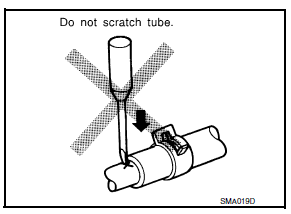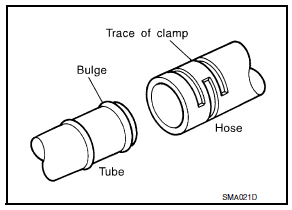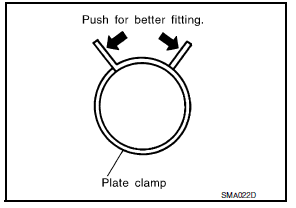Nissan Sentra Service Manual: Hoses
HOSE REMOVAL AND INSTALLATION
 To prevent damage to
To prevent damage to
rubber hose, do not pry off rubber hose with
tapered tool or screwdriver.
 To reinstall the
To reinstall the
rubber hose securely, make sure that hose insertion
length and orientation is correct. (If tube is equipped with hose stopper,
insert rubber hose into tube until it butts up against hose
stopper.)
HOSE CLAMPING
 If old rubber hose
If old rubber hose
is re-used, install hose clamp in its original position
(at the indentation where the old clamp was). If there is a trace
of tube bulging left on the old rubber hose, align rubber hose at
that position.
Discard old clamps; replace with new ones.
 After installing
After installing
plate clamps, apply force to them in the direction of
the arrow, tightening rubber hose equally all around.
 Multiport Fuel Injection System or Engine Control System
Multiport Fuel Injection System or Engine Control System
Before connecting or disconnecting any harness connector for the
multiport fuel injection system or ECM:
Turn ignition switch to “OFF” position.
Disconnect negative battery ter ...
 Engine Oils
Engine Oils
Prolonged and repeated contact with used engine oil may cause skin cancer.
Try to avoid direct skin contact
with used oil.
If skin contact is made, wash thoroughly with soap or hand cleaner as s ...
Other materials:
Clutch master cylinder
Exploded View
Reservoir hose
Reservoir tank
Clutch master cylinder
Removal and Installation
REMOVAL
CAUTION:
Keep painted surface on the body or other parts free of clutch
fluid. If it spills, wipe up immediately
and wash the affected area with water.
Do not disassemble c ...
System initialization
Description
If any of the following operations are performed, the initialization is
necessary for normal operation of power
window system.
Disconnection and connection of battery cable from negative terminal.
When power window main switch replaced.
Electric power supply to power window m ...
Checking engine oil level
Park the vehicle on a level surface and apply
the parking brake.
Start the engine and let it idle until it reaches
operating temperature.
Turn off the engine. Wait more than
10 minutes for the oil to drain back into
the oil pan.
Remove the dipstick and wipe it clean. Reinsert
...
